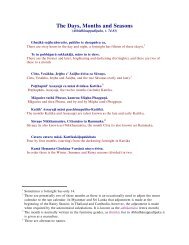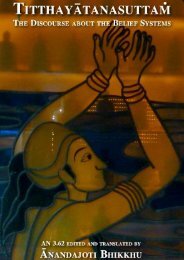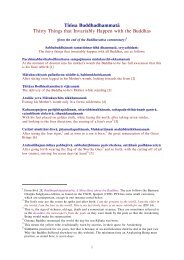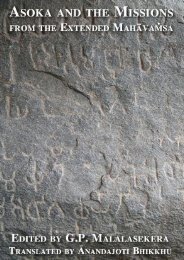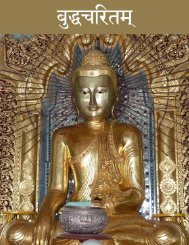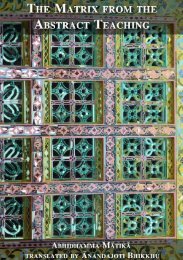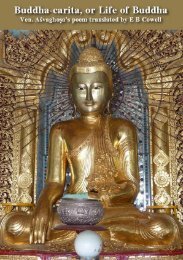The Sanskrit Text of Buddha-carita AÅvaghoá¹£a - buddhanet-de-index
The Sanskrit Text of Buddha-carita AÅvaghoá¹£a - buddhanet-de-index
The Sanskrit Text of Buddha-carita AÅvaghoá¹£a - buddhanet-de-index
- No tags were found...
Create successful ePaper yourself
Turn your PDF publications into a flip-book with our unique Google optimized e-Paper software.
Introduction to the <strong>Text</strong> - 82. Vaṁśastha (124 verses)Closely related to the Upajāti meter is Vaṁśastha, which is <strong>de</strong>rived from the 12syllable Jagatī class <strong>of</strong> metres. <strong>The</strong> metre though is much more restricted thatUpajāti or Jagatī, having a very <strong>de</strong>finite scheme to the metre that occurs in all fourlines:⏑−⏑−¦−⏑⏑¦−⏑−⏑×which is similar then to the Upendravajrā metre (⏑−⏑−¦−⏑⏑¦−⏑−⏓) in theUpajāti class, with an extra light syllable in penultimate position. Here again thecaesura is <strong>of</strong> no significance.Nearly the whole <strong>of</strong> Chapter VIII is written in this metre; and it’s Classicalstructure also ma<strong>de</strong> it a favorite at the conclusion <strong>of</strong> Chapters in the work, so that arun <strong>of</strong> 16 verses in Vaṁśastha metre is used to conclu<strong>de</strong> Chapter XII, and there are3 verses in this metre at the conclusion <strong>of</strong> Chapter VI; besi<strong>de</strong>s these Vaṁśastha isalso used as a run up to the concluding verse in a different metre in Chapters III,IV, IX, and XIII.3. Śloka (297 verses)I have elsewhere <strong>de</strong>scribed the Śloka metre, as being an Addhasamavutta metre. 1This holds true for the early stages <strong>of</strong> Indian prosody, but by Aśvaghoṣa’s time, theAddhasamavutta metres had changed consi<strong>de</strong>rably, in that nearly all the syllablesare fixed in weight, and the Śloka, which has very variable quantities will nolonger fit into the category.By far the most common form <strong>of</strong> the metre is the pathyā, which in this text showsthe following form:⏓⏓⏓⏓¦⏑−−⏓¦¦⏓⏓⏓⏓¦⏑−⏑×in the 2nd and 3rd positions <strong>of</strong> each pāda, two successive light syllables are notallowed; and in the opening <strong>of</strong> the posterior half <strong>of</strong> the line the pattern ⏓−⏑− isnot allowed. 21 See the Appendix on the Siloka and Tuṭṭhubha metres in my Outline <strong>of</strong> the Metres in thePāḷi Canon.2 As with Upajāti the sandhi shows that the two lines were taken together in pronounciation,without a pause at the end <strong>of</strong> the line.




